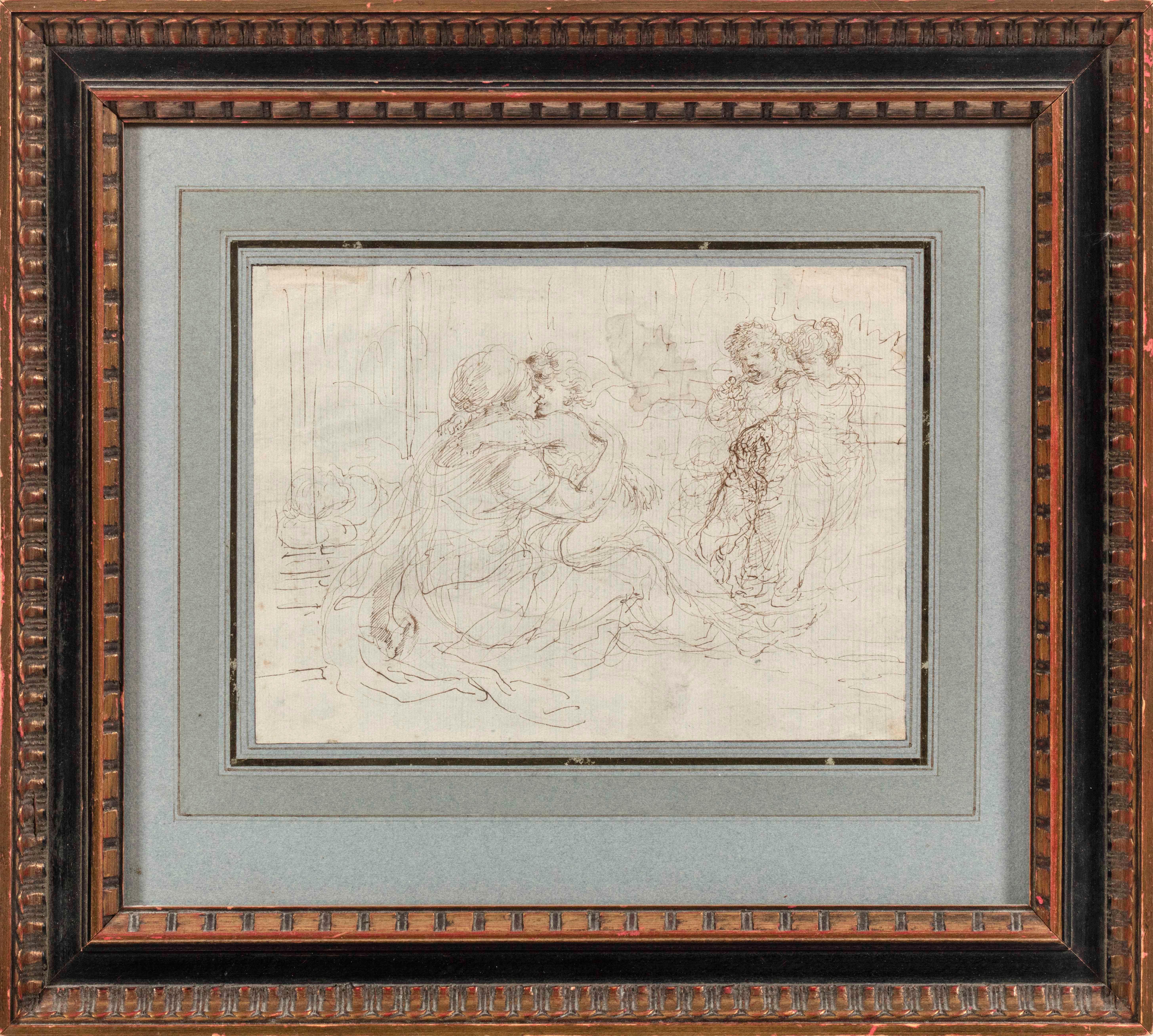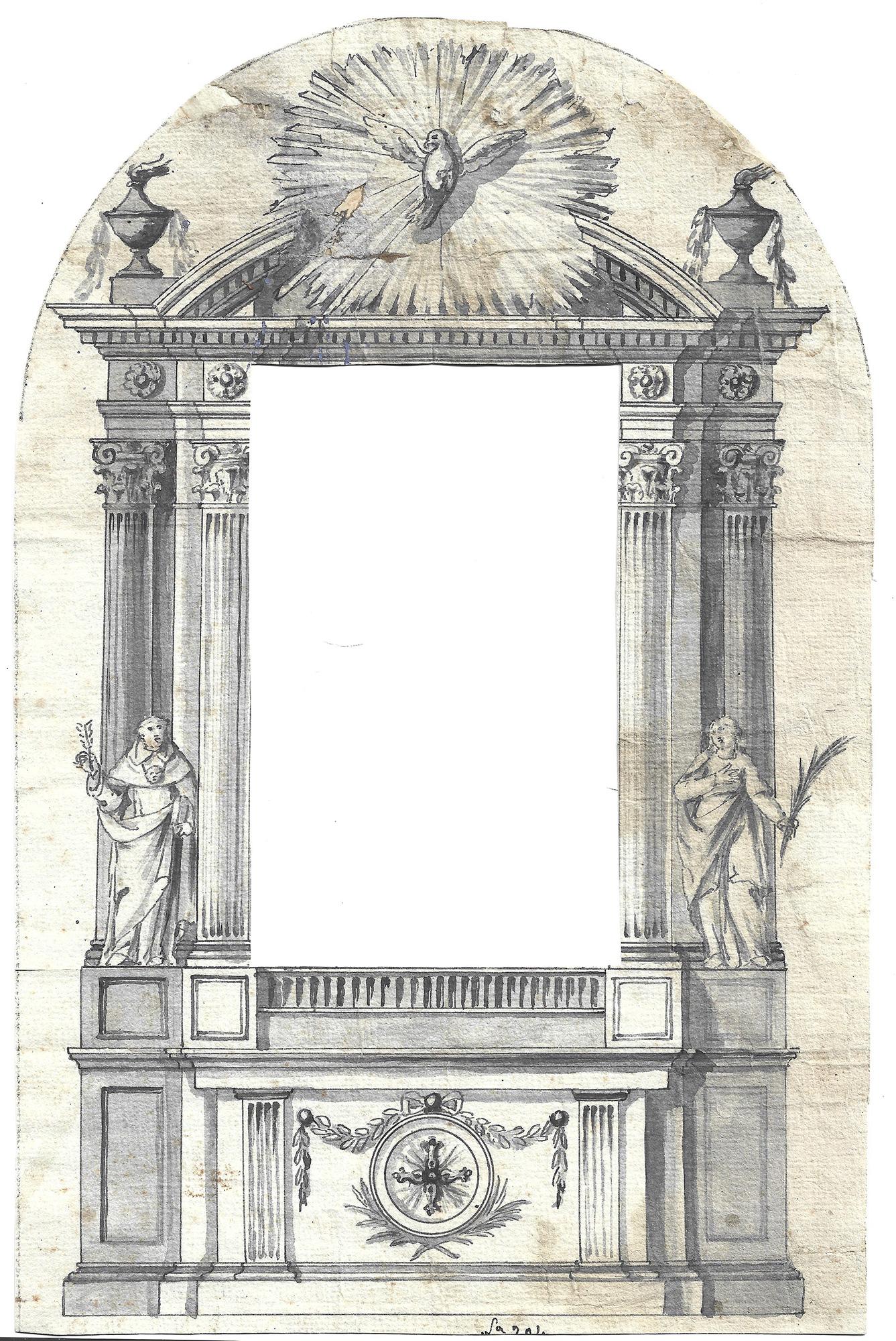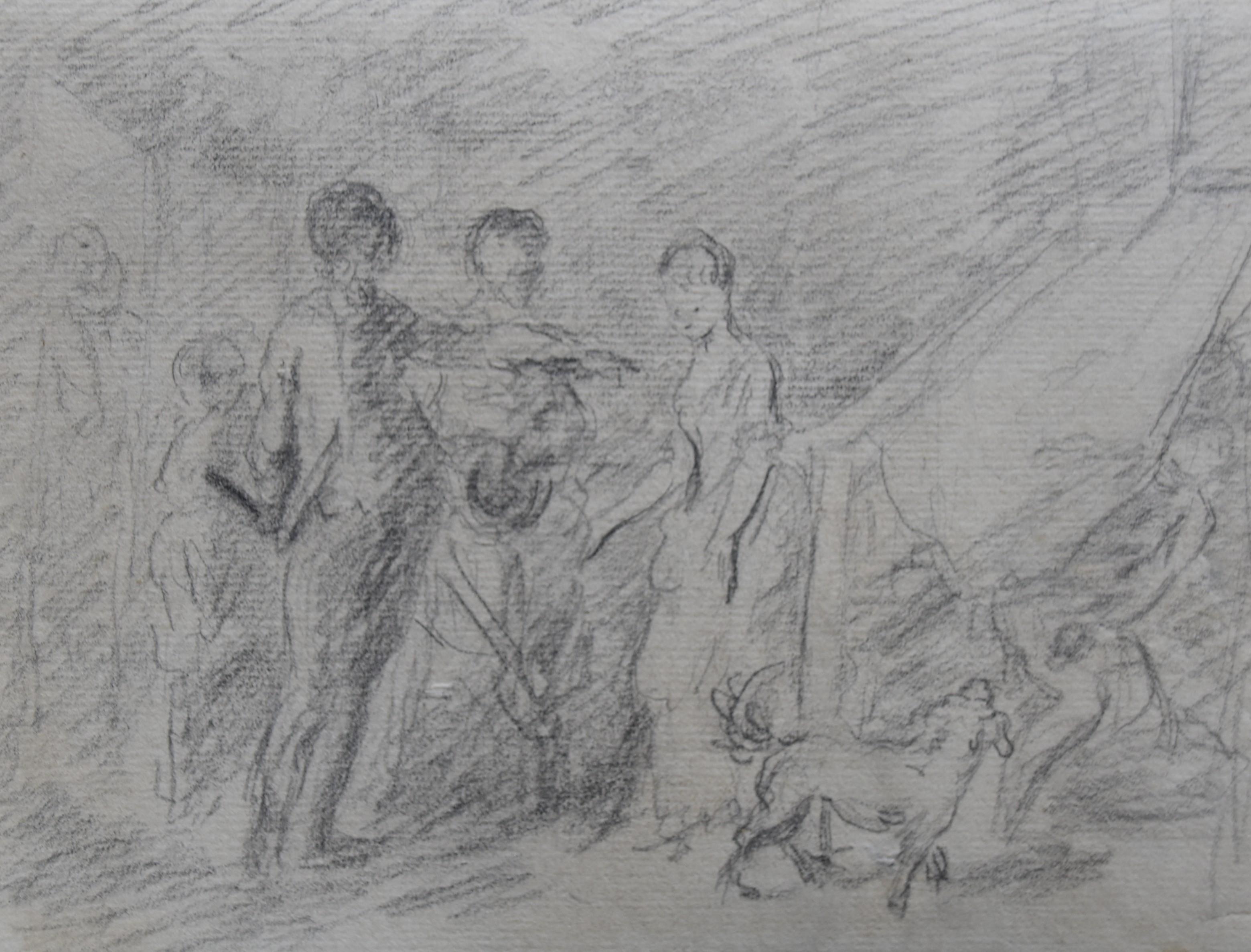Items Similar to William Moritz (1816-1860) An historical scene, drawing signed
Video Loading
Want more images or videos?
Request additional images or videos from the seller
1 of 11
William MoritzWilliam Moritz (1816-1860) An historical scene, drawing signedcirca 1850
circa 1850
About the Item
William Moritz (1816-1860)
An historical scene,
signed lower left
Brown ink and brown ink wash on paper
17 x 16.5 cm
Framed : 27 x 23.5 cm
The subject of this charming drawing remains unclear but it's really easy to identify Queen Anne of Austria, regent of France and her prime minister Cardinal Mazarin on the left of the composition.
William Moritz was born on 25 May 1816 in Neuchatel and died in Bern on 27 February 1860. He was called William Moritz the younger because he was the son of the painter Friedrich-Wilhelm Moritz from Herborn (1783-1854) and also his pupil.
He was a genre and landscape painter as well as a painter of orientalist scenes. Some of his works are kept in the museums of Bern and Neuchatel.
Few works by him are known, which is obviously due to the fact that he died quite young.
- Creator:William Moritz (1816 - 1860, Swiss)
- Creation Year:circa 1850
- Dimensions:Height: 6.7 in (17 cm)Width: 6.5 in (16.5 cm)
- Medium:
- Movement & Style:
- Period:
- Condition:
- Gallery Location:Paris, FR
- Reference Number:1stDibs: LU1112212033002
About the Seller
5.0
Platinum Seller
These expertly vetted sellers are 1stDibs' most experienced sellers and are rated highest by our customers.
Established in 2018
1stDibs seller since 2019
209 sales on 1stDibs
Typical response time: <1 hour
- ShippingRetrieving quote...Ships From: Paris, France
- Return PolicyA return for this item may be initiated within 14 days of delivery.
More From This SellerView All
- 18th Century Roman School , A Palazzo with antiques, drawingLocated in Paris, FR18th Century Roman School A Palazzo with antiques Brown ink and pen, brown ink wash on paper 12.5 x 20 cm Framed : 28,5 x 35.5 This nice drawing represents a genre scene, with a nobleman, priests, a mother and her children...Category
Early 18th Century Old Masters Interior Drawings and Watercolors
MaterialsInk
- 18th Century School, Courtyard of a palazzo, Architectural Capriccio, drawingLocated in Paris, FR18th Century french School, Courtyard of a ruined palazzo, An Architectural Capriccio, Pen and black ink and black ink wash on paper 17 x 12 cm In good condition Framed : 32 x 26 c...Category
1780s Old Masters Interior Drawings and Watercolors
MaterialsInk
- France 18th Century, The Surprised Lovers, original drawingLocated in Paris, FRFrance circa 1770 Two lovers surprised in bed Black chalk on paper 13 x 17 cm Modern frame : 34 x 38 cm This drawing had been attributed to Gabriel de Saint Aubin (1724-1780). It's...Category
1760s Old Masters Interior Drawings and Watercolors
MaterialsChalk
- Episode of the Franco-Prussian war of 1870, a cantonment of soldiers, drawingLocated in Paris, FRFrench School 19th Century Episode of the Franco-Prussian war of 1870, a cantonment of soldiers during the siege of Paris Pen and brown ink on paper 15 x 23 cm Annotated on the lower...Category
1870s Realist Interior Drawings and Watercolors
MaterialsInk
- French Romantic School, View of a roman atrium, drawingLocated in Paris, FRFrench Romantic school circa 1850 An antique Roman Atrium Ink, Ink wash and white gouache heightenings 30 x 13.5 cm Framed 42 x 34 cm, the frame is old and damaged (see detail pict...Category
1850s Romantic Interior Drawings and Watercolors
MaterialsInk
- Louis Tinayre (1861-1942) An encampment of journalists, signed drawingLocated in Paris, FRLouis Tinayre (1861-1942) An encampment of journalists in Chambéry, signed and titled lower left "Campement de journalistes à Chambéry" Ink on paper In quite good condition, a a visible vertical fold in the centre, some stains and foxings 21 x 29 cm Framed : 33.7 x 45.5 cm Louis Tinayre's background and adventurous life obviously shed light on this humorous and detailed scene. He shows a remarkable sense of observation, capturing as a journalistic illustrator this scene of extraordianarian life. We don't know for the moment why these journalists had to improvise a camp, probably in a hotel room. No doubt it was to cover a trial or a sensational news item that had filled all the hotels in the city with journalists who had flocked for the occasion. In any case, what interests Tinayre as an almost ethnographic observer is this camp of journalists, of which he makes a tender and comical scene. One understands him better when one knows how he could be fascinated in the same way by the territories of Madagascar, the North Pole or the Far West that he painted and drew. Louis Tinayre was born on 14 March 1861 in Neuilly-sur-Seine. His mother, Victoire Tinayre, was a teacher and a member of the International Workers' Association. Louis was the son of a Communard couple. His father, Jean Joseph, known as Jules Tinayre (Issoire 1821 - Paris 1871) was shot during the Bloody Week. His mother, Victoire Tinayre, fled with her children. Louis was the first to be sent to Hungary, and the rest of the family (including his brother Julien) joined him there later. He studied Fine Arts at the Hungarian University of Fine Arts in Budapest. Returning to Paris in 1880 (after the amnesty), Louis Tinayre assiduously frequented Le Chat noir, where he met the positivists and Adèle Jacomet (Buenos Aires 1867-1946), whom he married in 1888. He became an animal painter and press illustrator and was sent by Le Monde Illustré to cover the second expedition to Madagascar (then under French protectorate) in 1895. He stayed there, fascinated, for six months and produced numerous drawings and photographs. Back in France, he created eight 5 x 4 meters dioramas presented at the National and Colonial Exhibition in Rouen in 1896. He returned to Madagascar in 1898 to prepare the creation of a giant panorama representing the surrender of Antananarivo in 1895. The Malagasy pavilion at the 1900 Universal Exhibition in Paris allowed him to admire the dioramas (on the ground floor) and the panorama (on the first floor). On his second trip, Tinayre took a Lumière cinematograph with him to document the daily life of the Malagasy people, no doubt to facilitate the design of the vast panorama. These short films were donated to the Cinémathèque française in 2009 by his grandson, Alain Tinayre. One of the admirers of Tinayre's drawings, watercolours, paintings and photographs at the Universal Exhibition was Prince Albert I of Monaco: from 1901 onwards, Tinayre accompanied him on his hunts, painting scenes in North Africa, Russia, the Far West (Wyoming) and the North Pole. Tinayre, the official painter of the Prince's scientific expeditions, left his name to a glacier. Together with the painter Alexandre Jean-Baptiste Brun, he painted the four murals in the large amphitheatre of the Oceanographic Institute in Paris. Louis Tinayre painted the figures while Alexandre Brun...Category
1890s Realist Interior Drawings and Watercolors
MaterialsInk
You May Also Like
- A Mother and Child, Two Children, and a DogBy Stefano Della BellaLocated in New York, NYProvenance: Elsie de Woolfe, Lady Mendl, Paris; by whom given in 1950 to: Arlene Dahl, New York (until 2021) Inventive, whimsical, and fantastic; delightful, imaginative, and maca...Category
17th Century Old Masters Interior Drawings and Watercolors
MaterialsPaper, Ink, Pen
- Design for a large wooden confessional from the Santoni WorkshopLocated in Middletown, NYPen and grayish black ink on cream laid paper, 11 1/8 x 7 1/4 inches (283 x 185 mm), with the center of the sheet removed to create a window frame. Scattered light surface soiling, a...Category
Mid-20th Century Old Masters Interior Drawings and Watercolors
MaterialsInk, Laid Paper
- Study for “The Artist’s Studio” 1820, Horace Vernet (French 1789-1820)By Émile Jean-Horace VernetLocated in Sydney, NSWHorace Vernet (French 1789-1863), Study for “The Artist’s Studio” 1820. This is a charming detailed pen and ink study for “Vernet’s The Artist’s Studio” which was painted in 1820. I...Category
19th Century Academic Figurative Drawings and Watercolors
MaterialsInk, Paper
- Convent interiorLocated in PARIS, FRHippolyte Victor Valentin SEBRON (Caudebec-en-Caux, 1801 – Paris, 1879) Convent interior Ink, pen and wash Signed and dated lower left 27,5 x 20 cm 1839 Pupil of Daguerre from the age of 29, Sebron entered the Ecole des Beaux-Arts in Paris under the teaching of Cogniet. He exhibited regularly at the Paris Salon between 1831 and 1878. First employed in the painting of dioramas, he then produced numerous paintings, particularly interiors of churches...Category
Early 19th Century French School Interior Drawings and Watercolors
MaterialsInk, Pen
- Maroco Tanger, Méchouar : L'amantLocated in STRASBOURG, FRThomas Henriot was born in 1980 in Besançon and lives between Marseille and Havana, Cuba. Graduated from the Institut National Supérieur d’Expression Plastique in Besançon in 2003 wi...Category
21st Century and Contemporary Interior Drawings and Watercolors
MaterialsIndia Ink
- “Dime a Dance” American Art Deco 20th Century Modernism Pin-Up Social RealismLocated in New York, NY“Dime a Dance” American Art Deco 20th Century Modernism Pin-Up Social Realism Arthur Rosenman Ross (1913 - 1981) “Dime a Dance”, 1933 Watercolor and Ink on Illustration Board 18” x 10 1/2 inches (sight) Signed Arthur Rosenman, ‘33 L/R 29 1/2”H x 25 1/2 inches ( Framed) Provenance: Estate of the artist. The Drawing is in very good condition. The period frame is solid, but could use some restoration. BIO Arthur Rosenman Ross was a key figure in automotive design at General Motors during America's "Golden Age" of auto design, the 1930's through the 1950s. He attended the Art Institute of Chicago from age 17, exhibiting a special interest for automotive renderings and the female figure. In 1934, he changed his name from Rosenman to Ross, fearing his Jewish ancestry could prejudice his career prospects. At age 20, he turned down job offers from MGM Studios in Hollywood and Duesenberg to work at General Motors alongside the Legendary Harley Earl in 1935. He was hand picked by Mr. Earl and assigned to GM's War and Camouflage Division in 1937 through WW2. It was during this pivotal period in which he executed some extraordinary military aircraft artworks, likely used between GM and America's military aeronautics companies in design preparation for WW2. General Motors played an important role in helping America's aircraft manufacturers preceding and during the war. Just after the war in 1945, Mr. Ross was rewarded by GM, being made Chief Designer of Cadillac, then two years later becoming Chief at Oldsmobile until his retirement in 1959. He was in large part responsible for some of GM's classic Cadillac designs such as the Cadillac Sixty Special, Fleetwood, LaSalle and GM's first concept car, the extraordinary Buick Y-Job. Mr. Ross was an exceptionally charismatic and vivacious man who quite by chance, befriended His idol, Salvador Dali at GM in 1955. They talked about art, cars and girls late into the evening, according to his son, Carter Ross. He had a gift in rendering the erotic arts...Category
1930s Art Deco Figurative Drawings and Watercolors
MaterialsInk, Watercolor, Board
Recently Viewed
View AllMore Ways To Browse
Antique Dior
Diable Antique
William Sign
William Wells
Masters Drawings Signed
Old Master Drawings
William French
William A French
Antique Figurative Drawings and Watercolors
William And Son
William Master
William Old
William Young
Old Master Drawings Framed
Genre Paintings Interior
Prime Minister
Antique Cardinal
Dior Wash





